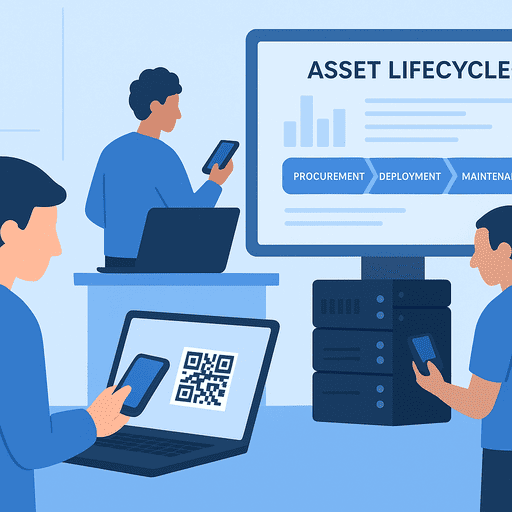Best Practices for IT Asset Lifecycle Management
Discover IT asset lifecycle management best practices to reduce costs, improve compliance, and extend the value of your tech investments.

Introduction
From laptops and smartphones to servers and networking gear, IT assets are the backbone of modern businesses. But without proper management, these assets become a source of hidden costs, inefficiencies, and compliance risks.
That’s why IT Asset Lifecycle Management (ITALM) is essential. It ensures every device is tracked — from purchase to disposal — while maximizing its value.
In this article, we’ll explore best practices for IT asset lifecycle management, common mistakes to avoid, and how to make the process efficient with modern tools.
What Is IT Asset Lifecycle Management?
IT Asset Lifecycle Management is the process of tracking and managing technology assets from the moment they’re purchased until they’re retired or recycled.
The lifecycle typically includes:
- Planning — Identifying needs and budgeting.
- Procurement — Purchasing and tagging assets.
- Deployment — Assigning assets to employees or departments.
- Use and Maintenance — Monitoring performance, upgrades, and support.
- Retirement and Disposal — Securely decommissioning or recycling.
Without a structured lifecycle, businesses risk overspending, data breaches, and lost productivity.
Common Problems Without ITALM
Organizations that lack lifecycle management often face:
- Shadow IT — untracked devices outside official systems.
- Compliance risks — missing audit trails for licenses or sensitive data.
- High costs — paying for unused software or maintaining outdated hardware.
- Poor security — old devices not wiped before disposal.
- Employee frustration — delays in getting working devices.
ITALM turns chaos into control.
Best Practices for IT Asset Lifecycle Management
1. Standardize Asset Procurement
- Define approved vendors and models.
- Buy in bulk for discounts and consistency.
- Record every purchase in a centralized system.
This avoids duplicate orders and ensures compatibility across your IT environment.
2. Use Unique Identification Tags
- Assign each asset a QR code or barcode.
- Track serial numbers, purchase dates, and assigned users.
- Link IDs to digital records for easy audits.
👉 For more on tracking methods, see our guide on Barcode vs QR Code Tracking.
3. Automate Deployment and Tracking
- Use mobile apps to check devices in and out.
- Log user assignments automatically.
- Integrate with HR systems to reassign assets during onboarding/offboarding.
Automation reduces manual errors and improves accountability.
4. Monitor Usage and Health
- Track asset performance and warranty details.
- Schedule preventive maintenance for servers, laptops, and network gear.
- Decommission devices before they become liabilities.
Monitoring helps you plan upgrades instead of reacting to breakdowns.
5. Manage Software Licenses
- Record software tied to each device.
- Reclaim unused licenses when employees leave.
- Ensure compliance with vendor terms to avoid legal issues.
Unmanaged software can be as costly as unmanaged hardware.
6. Plan for End-of-Life Early
- Define policies for asset replacement cycles (e.g., laptops every 3–4 years).
- Wipe data securely before recycling.
- Partner with certified e-waste vendors for disposal.
This protects sensitive information and aligns with sustainability goals.
7. Run Regular Audits
- Quarterly or semi-annual physical checks.
- Match physical assets with digital records.
- Identify lost, stolen, or underutilized devices.
Audits keep your inventory accurate and reliable.
Benefits of Strong IT Asset Lifecycle Management
1. Cost Savings
- Avoid overbuying hardware.
- Extend the lifespan of assets with maintenance.
- Reuse and reassign instead of purchasing new.
2. Compliance & Security
- Audit-ready records for regulators.
- Reduced risk of data leaks from improperly discarded devices.
3. Operational Efficiency
- Employees always have working devices.
- IT teams spend less time troubleshooting asset issues.
4. Strategic Planning
- Predict refresh cycles.
- Budget more accurately for IT investments.
Example: IT Asset Lifecycle in a Small Business
A 50-person company buys laptops without tracking. After 3 years:
- 10 laptops are unaccounted for.
- Several employees use outdated models.
- Old devices with sensitive data were donated without wiping.
With ITALM in place:
- Every laptop is tagged with a QR code.
- Usage and warranty are logged.
- End-of-life devices are securely wiped and recycled.
Best Practices Checklist
- Centralize procurement
- Tag every asset with a unique ID
- Automate assignment and checkouts
- Track performance and warranties
- Manage software licenses
- Securely dispose of retired devices
- Run regular audits
Common Mistakes to Avoid
- Relying only on spreadsheets → prone to errors.
- Forgetting software tracking → compliance nightmare.
- Skipping end-of-life planning → leads to security breaches.
- Ignoring employee input → creates frustration and low adoption.
Conclusion
IT Asset Lifecycle Management isn’t just for big enterprises — small and mid-sized businesses benefit just as much. By standardizing procurement, tagging assets, automating tracking, and planning for end-of-life, you can reduce costs, improve compliance, and keep your team productive.
A modern system ensures your IT assets work for you, not against you.
👉 Want a simple way to manage IT assets from purchase to disposal? Try InvyMate today — smart, QR-powered lifecycle management built for growing teams.